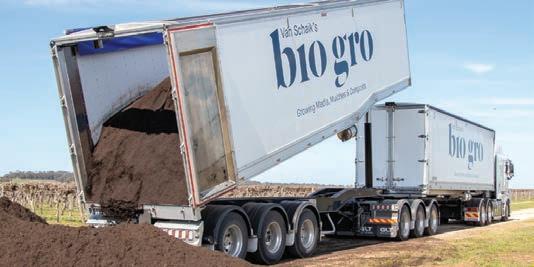
5 minute read
FROM GOOD TO GREAT
From good to great: a CDS opportunity
RETURN-IT CHIEF EXECUTIVE OFFICER MARC CHURCHIN BELIEVES TASMANIA AND VICTORIA ARE POSITIONED FOR A SHOT AT THE TITLE OF ‘BEST AUSTRALIAN CONTAINER DEPOSIT SCHEME’.
In a few years’ time, no one will be talking about which Australian jurisdiction was last, third last, or fifth last to introduce its Container Deposit Scheme (CDS). Marc Churchin, Chief Executive Officer of Return-It believes all the conversation will be around which is the best scheme.
He says there has been a false dichotomy suggesting the only choice for Tasmania or Victoria is to exactly follow New South Wales, or exactly follow Queensland. Both jurisdictions chose a ‘split responsibility’ model akin to the ACT and NSW.
However, having an appropriate governance mechanism does not have to limit innovation within the collection network. It also does not preclude the opportunities for community groups and charities, as evidenced across QLD and WA.
Re.Group is an Australian company that specialises in recycling and resource recovery. Back when NSW and the ACT first signalled their plans to introduce a modern CDS, Re.Group approached the challenge with a mindset that was technologically agnostic.
Marc says the approach strongly aligned with the values of balancing the needs of people, the planet and profit. This led to the establishment of Return-It. The company places special focus on forging relationships with various charities, social enterprises and community groups and embraces a broad range of technologies and systems from local and global providers.
“Return-It is now the biggest operator of container refund depots across Australia, working across the ACT, NSW, QLD and WA,” he says. “Do you know what is the big difference for customers in each state? Nothing. Every one of Return-It’s customers, from Canberra to Cairns and from Perth to Geraldton, gets the same 10c for returning the same eligible containers.”
So, if the fundamental service is the same in all Australian schemes – develop collection points that are safe and convenient, count and verify eligible containers, and pay customers the correct refund – how will the ‘best Australian CDS’ be judged?
Marc says it’s all about the ‘plus, plus’ aspects. This is determined by which jurisdiction does the best job of leveraging its CDS networks to create additional social and environmental benefits in a cost-efficient and sustainable way.
“The ACT chose to put humans at the centre of its scheme, with a deliberate effort to maximise social connection through staffed depots and integration of return points with existing charity stores.
“Since June 2018, the ACT CDS has continued to innovate and evolve – it’s a diverse and inclusive model, not a ‘one-size-fits-all’ approach.
“Don’t feel like talking to depot staff today? Then use one of the drop-and-go PODs open 24/7. Want to help the kids earn pocket money while teaching them about recycling? Go to a depot where they can feed their own bottles and cans onto a conveyor and walk out with cash
Social connection is a key element of a successful Container Deposit Scheme.
The ACT CDS is not a ‘one-size-fi ts-all’ approach.

in their hand. Need to clear the garage after last week’s big party? Go to a site where staff tip all your containers into a bulk counting machine for rapid service. And if you can’t or don’t want to leave home at all, use the ReCollect App to book a contactless home pick-up.”
Total container return rates in the ACT are comparable to NSW, as are the costs of delivering the CDS. Despite different approaches, with different economies of scale, both schemes end up in a similar place in terms of delivering the ‘core service’. Marc says what differentiates them, are those ‘plus, plus’ aspects in the collection network.
One important opportunity he sees for Victoria and Tasmania is to think ahead.
“The states should consider the much broader range of products that may be covered by Product Stewardship programs in the future. For example, Return-It already collects mobile phones and accessories via MobileMuster in its depots. This year Return-It is focusing on working with the Battery Product Stewardship Council’s Scheme to get batteries out of kerbside bins and into proper recycling channels.
“If we are serious about advancing toward a circular economy, we need to be thinking in terms of material pathways. It doesn’t matter whether that HDPE plastic container once held fl avoured milk, fresh milk, laundry detergent or shampoo – what matters is that we effi ciently capture and recycle the material so it can be kept at its highest and best use for as long as possible.”
He says that rather than thinking about CDS as a program that just manages some used beverage containers, we should be thinking about it as a new collection pathway for materials that could have a better recovery rate through a clean-stream than via a kerbside service.
“The ultimate goal is to recover those items in a way that maximises the value of the material, while also providing social benefi ts, benefi ts that will create new revenue streams and new connection points for the local community.”
vertical shredders. shredders. Built tough for the most demanding of shredding applications.
HEAVY DUTY VALUEFOR MONEY CIRCULAR ECONOMY

• Aggressive size reduction and densification of preshredded materials • Clean, high bulk density output for easy sorting and transportation • C&D waste, scrap metal and other heavy duty applications • Available with up to 440kW of power • Industry-proven and built tough for Australian conditions
















